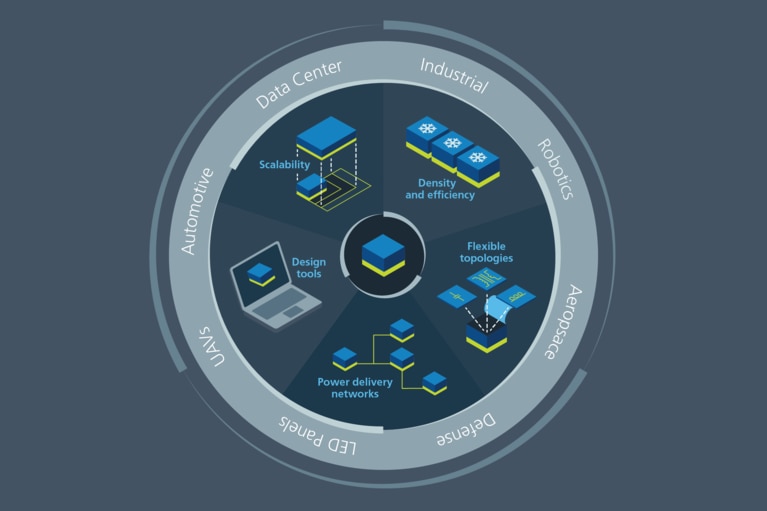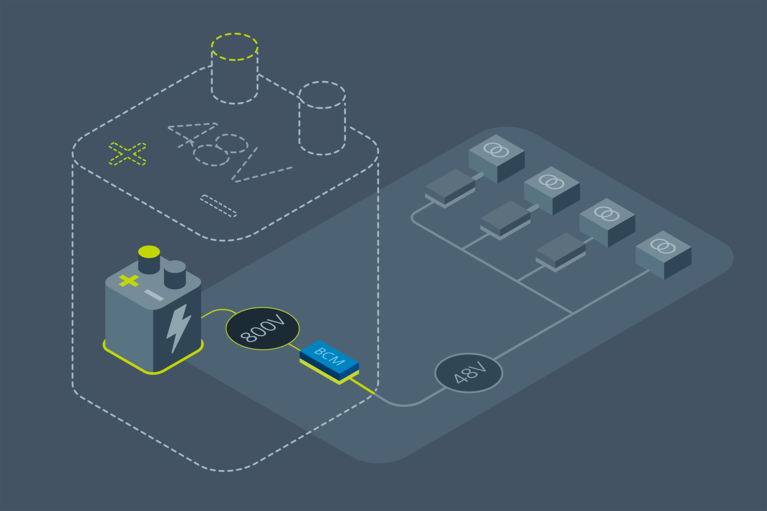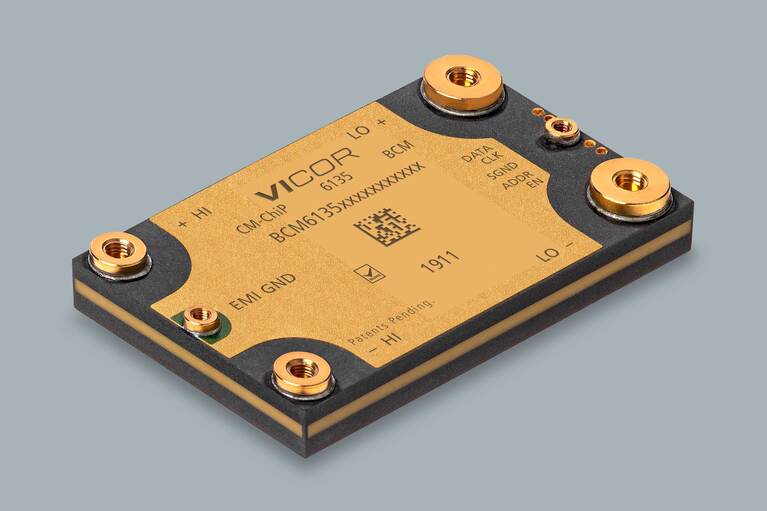
創新供電網路
關於 Vicor 如何創新供電網路領域的白皮書。 提升終端系統性能所需的電源技術
尊敬的用戶:
為了改進 Vicor 網站,我們將於美國東部時間 12 月 29 日上午 11:30 至下午 2:00 對網站進行維護。
在此期間,您可能無法查看網站的某些部分,特別是產品頁面和產品型號清單。
對於給您帶來的不便,我們深表歉意,並感謝您的耐心等待。
– Vicor 網站團隊
實現靈活性、可擴充性和最高的功率密度
Vicor 已建立了涵蓋產品設計、製造、模擬及選擇工具的電源模組能力。這種能力使 Vicor 能幫助電源系統設計人員便捷地部署從電源到負載點(PoL)的高效能供電網路(PDN),以實現擴充至眾多不同產業的終端系統,例如汽車、人工智慧/資料中心、國防與航空航太以及 LED 照明等。
這種模組化電源組件方法意味著電源行業的一種新標準,可通過一種方法滿足現代高效能終端系統不斷增長的電源需求,而且能提供更多電源系統優勢,例如更少的電源系統空間佔用、高效率以及更快的上市行程等。
如今,供電網路在許多行業的大量終端系統中正在迅速發生變化。這些不同系統的電源需求千差萬別,因此需要多樣化的模組組合,以實現使用模組化電源組件方法的最高靈活性。Vicor 提供的模組化電源解決方案包括:
除了上述這些,還有一些不同的控制特性,例如遙測、補償和可程式設計性,以及可能需要的任何行業/安全認證等。
要使用優化的解決方案有效地支持不同行業的不同 PDN,就需要一種全面的電源模組方法。使用電源模組符合大規模定制的實踐,而且可獲得優勢。大規模定制有助於在從通用設計及制造技術中獲益的同時,提供針對不同終端系統優化的獨特 PDN。此外,通用可擴充的設計及制造技術在加速上市行程、可靠性以及技術風險及成本管理方面也具有優勢。
Vicor 電源模組方法的關鍵要素有:
大量電源模組組合可實現多種 PDN 設計,提供了一系列功能、可擴充性及效能。借助電源系統設計工具和白板工具,不僅可從產品系列中為不同的供電架構選擇優化的電源模組,而且還可構建最高效能的 PDN(圖 1)。 這些工具提供了一個環境來分析不同的架構和模塊,以針對整體效能、成本或尺寸等考慮因素進行優化。模組化電源組件設計方法是 Vicor 電源模組方法中較為引人矚目的部分,因為客戶每天都會使用它與 Vicor 互動,它由大量的電源模組組合以及用於選擇和優化的工具提供支援。電源模組設計本身是 Vicor 電源模組的第二大要素,儘管這對於客戶而言並不顯眼,但對於提供大規模定制的優勢卻同樣重要。
圖 1:使用 Vicor 白板工具設計優化供電網路的示例。
Vicor 對靈活的開關拓撲進行了創新,可適應各種電源轉換功能和需求。拓撲的功能各不相同,一個電源模組中可使用一個或多個拓撲。Vicor 正弦振幅轉換器(SAC™) 拓撲是一款最常見的拓撲,可針對不同的電源需求快速配寘,主要通過改變模組設計中的 FET 和平面磁性元件實現。使用靈活的開關拓撲,可縮短開發時間,還可以降低為滿足特定應用需求而優化的新電源模組的風險。
Vicor 開發了CM-ChiP™ 通用封裝技術,以最大限度提高電源模組的密度和散熱效能。CM-ChiP 封裝是一種內部有中間層基板的 3D 封裝,可將組件佈置在上下兩面。封裝上下兩面的熱阻抗相等,必要時可進行雙面散熱。外部電鍍選項可為遮罩和終端連接提供高度的靈活性,包括表面貼裝、引脚及底座安裝終端。不同的外形或終端連接無需使用工具。使用 CM-ChiP 通用封裝技術,可為全新的電源模組設計實現更快的上市行程以及更高水准的效能預測(圖 2)。
圖 2:與現時同類最佳解決方案相比,Vicor 耐輻射電源模組的功率密度提高了 3-5 倍,100V 母線應用的功率損耗降低了 50%。
CM-ChiP 採用面板制造技術,該工藝與晶圓制造技術相似。這兩種工藝都支持從單塊面板或晶圓製造多個模組或器件,可在生產線上實現標準化。 該面板可以容納各種模組外形,並利用整塊面板生產盡可多的模組。面板制造技術是大規模定制的關鍵要素,可將製造重點從傳統的零散化、單一組件封裝支持及產量提高轉化為涵蓋所有產品的面板級工作。
PDN 架構及設計的靈活性包括能够並聯大多數電源模組,以充分滿足日益增長的系統電源需求。此外,Vicor 還可通過擴大電源模組本身的尺寸來新增模組供電。擴充可通過模塊線性擴展來完成,通過將內核模組設計修改為更高的功率水准來提高電源容量。另一個擴充方式是整數擴充,從面板中分離一個以上的基本模組,可實現 2 倍、3 倍,甚至 4 倍的電源容量(圖 3).
圖 3:面板制造技術的縮放方法:線性縮放(左)和整數縮放(右)。
當人工智慧(AI)處理器電源系統設計人員想在 AI 加速卡上最大限度提高其處理器效能時,他們把目光投向了 Vicor。處理器的電源效能需求要求在 1V 以下的電壓下提供 500A 以上的電流。此外,供電網路還需要適應行業標準的開放式計算平臺 OAM 卡,突破傳統多相降壓穩壓器的功率密度限制。

圖 4:先進的人工智慧處理器的供電網路,在低於 1V 的電壓下提供 500A 以上的電流。
Vicor 配寘了一個基於 SAC™ 拓撲的模組,K 因數為 1/48 的 MCM4609,安裝在尺寸為 46 x 9 x 3.2 毫米的 AI 處理器的南北兩側。每個 MCM4609 都能在 1V 以下的電壓下為處理器提供總共 325A 或 650A 的穩定電流。MCM4609 從 MCD4609 模組接收驅動訊號,形成完整的供電網路。AI PDN 提供了無與倫比的密度和接近處理器的位置,最大限度降低了 PCB 損耗。
圖 5:用於 AI 處理器供電的 MCM4609 電源模組。
與 AI 處理器的需求類似,在著手開發高密度電動汽車(EV)電池 PDN 時,Vicor 能够快速配寘一種基於 SAC 拓撲的模組來滿足這些需求(圖 6)。
圖 6:用於 800V 電動汽車電池電源轉換的供電網路。
電動汽車除了需要底盤安裝封裝外,還需要 48V 電源軌,從主電池為汽車中的非電機負載提供支援。 要以高效、輕量級的方式從 800V 電池提供 48V 電壓,傳統解決方案是有局限性的。
因此,Vicor 開發了一種基於 SAC 拓撲的模組,K 因數為 1/16,採用較大的 CM-ChiP 封裝(與 AI MCM4609 相比),適應更高的功率以及底盤安裝。電源模組 BCM6135 採用 61 x 35 x 7.4 毫米 CM-ChiP 封裝,在電流為 80A(或輸出功率為 3.8kW )時,可提供 800VIN 至 48VOUT 的轉換,效率超過 97%(圖 7)。
圖 7:用於電動汽車電池電壓轉換的 BCM6135 電源模組。
BCM6135 下游的其它電源模組支持穩壓的 12V 和 48V,形成完整的供電網路。BCM6135 及下游電源模組的高密度和高效率内容可實現更輕的重量以及更高效能的電動汽車電池轉換( 圖 5)。
Vicor 在可配置和可擴展封裝方面的創新與電源設計拓撲結構的創新相結合,實現了模組化的 PDN 方法,為眾多行業提供了高功率密度和高效率。汽車和資料中心應用解決方案表明,僅僅縮小尺寸是不够的。最大的影響來自於將這些創新結合起來,並採用模組化方法來解决最棘手的電源挑戰。
本文最初由 Power Electronics Europe 發表。









